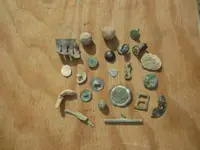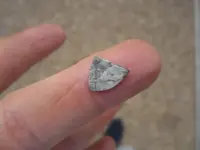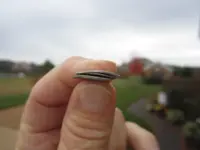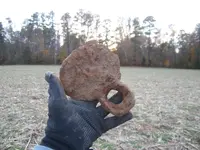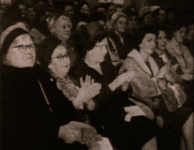Bill D. (VA)
Silver Member
- Joined
- Oct 7, 2008
- Messages
- 4,711
- Reaction score
- 6,212
- Golden Thread
- 6
- Location
- SE Virginia
- 🥇 Banner finds
- 6
- 🏆 Honorable Mentions:
- 2
- Detector(s) used
- F75 SE (land); CZ-21 (saltwater)
- Primary Interest:
- Other
Another colonial silver recovered during Saturday's hunt
My good friend Dan and I finally made it back to the ugly cut cornfield that produced 3 cut pieces of silver on our first hunt there. We had been led to believe the remaining corn stalks had been mowed down, but when we arrived we could see that was not the case. After meeting with the owner and some of his family members for over an hour we finally made our way back to the field. It was the usual slow going, but we now feel confident that some kind of occupied site was located on the higher ground, especially after Dan was able to uncover what appeared to be part of the brick foundation. Since this area is immediately adjacent to one of our early, mega-productive sites we figured it just might be another tenant house. After Dan recovered an early LC on his very first target it didn't take me long to follow suit. This one was reading in the mid-20s on my F75, and I thought it might be a tombac or small buckle piece. But much to my surprise a tiny piece of silver emerged. It's quite small and super thin, and was also very worn. On one side we initially thought we could see part of a cross that might indicate a cob. But it's much too thin for that, and we later got thinking that maybe it could be part of a hammered coin. Guess we'll never know as the only clue is what looks to be an "8" on one side (the other is slick). Could that be the last digit of the date?? One of the pics below demonstrates how thin this piece is when sandwiched between the 2 cut pieces found on the last hunt. A little later we explored a spring stream at the bottom of an adjacent ravine that was littered with early brick. I got a large and deep iron signal in the bottom of the stream bed, but neither Dan nor I could excavate it due to the water being a little too deep, and we didn't have our water boots with us. But that will be something to check out on the next trip. At that point we moved on to check out some other promising looks spots on the property. But we ended up with a big goose egg until we hit one last spot just as it was getting late. I found an iron patch on some high ground near the edge of the woods, but was disappointed to realize that it was probably from a mid-1800s site based on the few finds I was able to recover. But as Dan mentioned in his post, he found what appeared to be a small 17th century site in a low area just in front of where I was hunting (where he found his cob). I dug a couple items from that area including a cute little colonial hoe right before we called it quits. I've dug quite a few broad hoes over the years, but this one is by far the smallest. It's currently cooking in the electrolysis tank. We hope to hit the cornfield site again, especially since being told by the farmer that he was definitely going to have the stalks cut down soon. And another adjacent area should be cropped as well by the time we can return in a week or 2. Wasn't the most productive hunt, but still had fun on a beautiful, crisp "chamber of commerce" fall day in rural eastern Virginia.
UPDATE: After taking a close look at that tiny piece of silver, I believe it does have a chance to be from a hammered coin. In the first pic below I compare it to one of my 1500s sixpences. What Dan and I originally thought might have been a Spanish cross may actually be a part of the shield on the reverse of a Lizzie silver. The "8" appears to be in a position to be the 3rd digit in the date, which could make this a 1580s coin. It may be wishful thinking on my part, but you never know. Appreciate any comments especially from those guys across the pond.
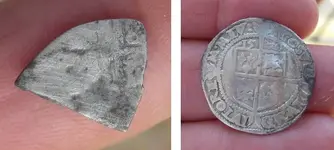
My good friend Dan and I finally made it back to the ugly cut cornfield that produced 3 cut pieces of silver on our first hunt there. We had been led to believe the remaining corn stalks had been mowed down, but when we arrived we could see that was not the case. After meeting with the owner and some of his family members for over an hour we finally made our way back to the field. It was the usual slow going, but we now feel confident that some kind of occupied site was located on the higher ground, especially after Dan was able to uncover what appeared to be part of the brick foundation. Since this area is immediately adjacent to one of our early, mega-productive sites we figured it just might be another tenant house. After Dan recovered an early LC on his very first target it didn't take me long to follow suit. This one was reading in the mid-20s on my F75, and I thought it might be a tombac or small buckle piece. But much to my surprise a tiny piece of silver emerged. It's quite small and super thin, and was also very worn. On one side we initially thought we could see part of a cross that might indicate a cob. But it's much too thin for that, and we later got thinking that maybe it could be part of a hammered coin. Guess we'll never know as the only clue is what looks to be an "8" on one side (the other is slick). Could that be the last digit of the date?? One of the pics below demonstrates how thin this piece is when sandwiched between the 2 cut pieces found on the last hunt. A little later we explored a spring stream at the bottom of an adjacent ravine that was littered with early brick. I got a large and deep iron signal in the bottom of the stream bed, but neither Dan nor I could excavate it due to the water being a little too deep, and we didn't have our water boots with us. But that will be something to check out on the next trip. At that point we moved on to check out some other promising looks spots on the property. But we ended up with a big goose egg until we hit one last spot just as it was getting late. I found an iron patch on some high ground near the edge of the woods, but was disappointed to realize that it was probably from a mid-1800s site based on the few finds I was able to recover. But as Dan mentioned in his post, he found what appeared to be a small 17th century site in a low area just in front of where I was hunting (where he found his cob). I dug a couple items from that area including a cute little colonial hoe right before we called it quits. I've dug quite a few broad hoes over the years, but this one is by far the smallest. It's currently cooking in the electrolysis tank. We hope to hit the cornfield site again, especially since being told by the farmer that he was definitely going to have the stalks cut down soon. And another adjacent area should be cropped as well by the time we can return in a week or 2. Wasn't the most productive hunt, but still had fun on a beautiful, crisp "chamber of commerce" fall day in rural eastern Virginia.
UPDATE: After taking a close look at that tiny piece of silver, I believe it does have a chance to be from a hammered coin. In the first pic below I compare it to one of my 1500s sixpences. What Dan and I originally thought might have been a Spanish cross may actually be a part of the shield on the reverse of a Lizzie silver. The "8" appears to be in a position to be the 3rd digit in the date, which could make this a 1580s coin. It may be wishful thinking on my part, but you never know. Appreciate any comments especially from those guys across the pond.

Amazon Forum Fav 👍
Attachments
Last edited:
Upvote
9



